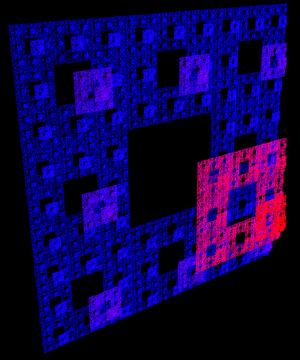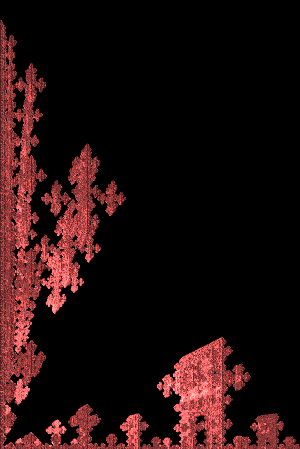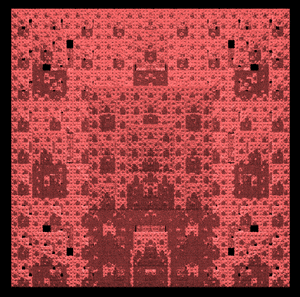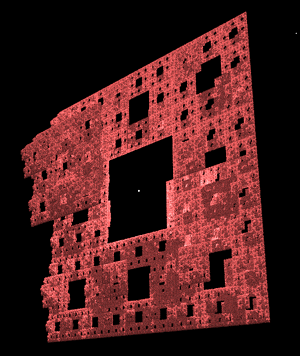Octahedral Sierpinski Carpetor
Using Tachyon to render large numbers of spheresBased on work by Roger BagulaMarch 2001
This document has two purposes, firstly to explore a fractal object brought to my attention by Roger Bagula, the second to test the ability of a new rendering package called Tachyon to handle large numbers of spheres. The object in question is created as a 3 dimensional IFS (Iterated Function System). In essence one moves from the current position towards a randomly chosen point from a set of points, on each move a "marker" is deposited at the current position. In this case the set of points lie at the vertices of an octahedron, the resulting form is similar in appearance to the Sierpinski carpet. Such geometry is often hard to visualise. Using non shaded techniques such as OpenGL tends to result in confusing masses of "dots" because there isn't enough occlusion. Sampling onto a 3D grid for use with a volume renderer isn't satisfactory because the voxel cells can't be made small enough to reflect the fractal structure. The problem if one wishes to raytrace these objects is that they take a long time to evolve and therefore whichever primitive is drawn at each point needs to be able to be rendered efficiently. For a raytracer a sphere is normally chosen. For all the examples shown on the right one million spheres were used. On average these took in the order on 30 seconds to 5 minutes to render depending on the level of antialiasing, ray depth, and image size. These timings are for a Dec Alpha ES40 (4 processor machine but only one processor was used unless indicated otherwise). The Tachyon scene file follows.begin_scene resolution 1000 1000 camera zoom 1 aspectratio 1 antialiasing 4 raydepth 6 center 5 0 0 viewdir -5 0 0 updir 0 1 0 end_camera texdef themat ambient 0.2 diffuse 0.8 specular 0.5 opacity 1 color 1 0.4 0.4 texfunc 0 light center 0 4 -4 rad 0.01 color 1 1 1 light center 0 4 4 rad 0.01 color 1 1 1 light center 0 0 0 rad 0.01 color 1 1 1 # This is the output from create.c include 1000000.inc end_scene For details on the file "1000000.inc" see the create.c program below, it basically creates a file consisting of a large number of "sphere" primitives. For example:
sphere center -0.7276 0.3077 -0.0040
rad 0.001
themat
C Source to create the points from the IFS: create.c. These are represented as sphere primitives for Tachyon.
The example below with the colour ramp will be left up to the reader to create. The models here simply mapped z axes depth onto a colour ramp. They were rendered with spheres half the radius as before (0.001) but there were twice as many (2 million) of them, the images were also created at 2K by 2K pixels, with antialiasing of 4 and raydepth of 6. Each sphere now needs it's own material specification, for example:
sphere center -0.72765 0.307711 -0.00406442
rad 0.001
texture ambient 0.2 diffuse 1
specular 0.75 opacity 1
color 0.99 0.005 0 texfunc 0
Using the threaded version 0.93.1 of Tachyon on a 4 processor Dec Alpha ES40 this rendering took 90 seconds, 915 MB RAM. 
|



